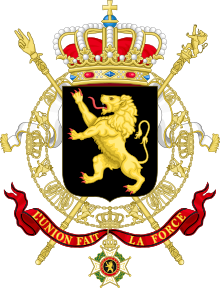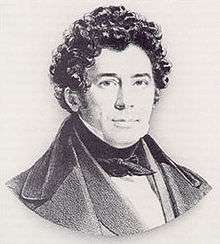1866 Belgian general election
Partial general elections were held in Belgium on 12 June 1866.[1][2] In the elections for the Chamber of Representatives the result was a victory for the Liberal Party, which won 70 of the 122 seats.[2] Voter turnout was 70%, although only 51,465 people were eligible to vote.
| |||||||||||||||||||||||||||||||
61 of the 122 seats in the Chamber of Representatives 62 seats needed for a majority | |||||||||||||||||||||||||||||||
|---|---|---|---|---|---|---|---|---|---|---|---|---|---|---|---|---|---|---|---|---|---|---|---|---|---|---|---|---|---|---|---|
| |||||||||||||||||||||||||||||||
| |||||||||||||||||||||||||||||||
 |
|---|
| This article is part of a series on the politics and government of Belgium |
|
|
|
|
Federal Cabinet |
|
|
Under the alternating system, elections were only held in four out of the nine provinces: Hainaut, Limburg, Liège and East Flanders. Special elections were held in the arrondissements of Antwerp, Brussels and Leuven.
Results
Chamber of Representatives
| Party | Votes | % | Seats | ||
|---|---|---|---|---|---|
| Won | Total | +/– | |||
| Liberal Party | 20,965 | 58.2 | 43 | 70 | +6 |
| Catholics | 15,060 | 41.8 | 18 | 52 | 0 |
| Invalid/blank votes | 2,908 | – | – | – | – |
| Total | 38,933 | 100 | 61 | 122 | +6 |
| Registered voters/turnout | 51,465 | 70.0 | – | – | – |
| Source: Mackie & Rose,[3] Sternberger et al. | |||||
Constituencies
The distribution of seats among the electoral districts was as follows for the Chamber of Representatives, with the difference compared to the previous election due to population growth:[4]
| Province | Arrondissement | Seats | Change |
|---|---|---|---|
| Antwerp | Antwerp | 6 | +1 |
| Mechelen | 3 | – | |
| Turnhout | 3 | – | |
| Limburg | Hasselt | 2 | – |
| Maaseik | 1 | – | |
| Tongeren | 2 | – | |
| East Flanders | Aalst | 3 | – |
| Oudenaarde | 3 | – | |
| Gent | 8 | – | |
| Eeklo | 1 | – | |
| Dendermonde | 3 | – | |
| Sint-Niklaas | 3 | – | |
| West Flanders | Bruges | 3 | – |
| Roeselare | 2 | – | |
| Tielt | 2 | – | |
| Kortrijk | 4 | – | |
| Ypres | 3 | – | |
| Veurne | 1 | – | |
| Diksmuide | 1 | – | |
| Ostend | 1 | – | |
| Brabant | Leuven | 5 | +1 |
| Brussels | 13 | +2 | |
| Nivelles | 4 | – | |
| Hainaut | Tournai | 4 | – |
| Ath | 2 | – | |
| Charleroi | 5 | +1 | |
| Thuin | 3 | +1 | |
| Mons | 5 | – | |
| Soignies | 3 | – | |
| Liège | Huy | 2 | – |
| Waremme | 1 | – | |
| Liège | 8 | +1 | |
| Verviers | 3 | – | |
| Luxembourg | Arlon | 1 | – |
| Marche | 1 | – | |
| Bastogne | 1 | – | |
| Neufchâteau | 1 | – | |
| Virton | 1 | – | |
| Namur | Namur | 4 | – |
| Dinant | 2 | – | |
| Philippeville | 2 | +1 | |
| 124 | +8 |
gollark: Metric units are actually consistent, grounded in sensible things, and can be converted easily.
gollark: No. Metric IS superior.
gollark: You can use Discord *and* ride a bike at the same time?
gollark: Through a ridiculously large amount of different platforms, though, so you can't really buy your own stuff back.
gollark: Clearly I have mildly underestimated them!
References
- Codebook Constituency-level Elections Archive, 2003
- Sternberger, D, Vogel, B & Nohlen, D (1969) Die Wahl der Parlamente: Band I: Europa - Erster Halbband, p105
- Thomas T Mackie & Richard Rose (1991) The International Almanac of Electoral History, Macmillan, pp48–49
- List of members of the Chamber of Representatives (1866-1967)
This article is issued from Wikipedia. The text is licensed under Creative Commons - Attribution - Sharealike. Additional terms may apply for the media files.

